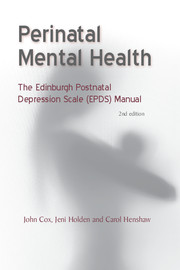Book contents
- Forntmatter
- Contents
- The authors
- Acknowledgments
- Abbreviations
- List of Figures
- Foreword
- Preface to the First Edition
- Preface to the Second Edition
- 1 Postnatal Depression: An Overview
- 2 The Origins and Development of the Edinburgh Postnatal: Depression Scale
- 3 International and Cross-Cultural Issues
- 4 Using the Edinburgh Postnatal Depression Scale in Clinical: Settings: Research Evidence
- 5 Humanistic and Person-Centred Interventions in Perinatal Depression
- 6 Screening and Intervention Services in the Community
- 7 Using the Edinburgh Postnatal Depression Scale
- Appendix 1 The Edinburgh Postnatal Depression Scale
- Appendix 2 Translations of the Edinburgh Postnatal Depression Scale
- References
- Index
4 - Using the Edinburgh Postnatal Depression Scale in Clinical: Settings: Research Evidence
Published online by Cambridge University Press: 05 February 2021
- Forntmatter
- Contents
- The authors
- Acknowledgments
- Abbreviations
- List of Figures
- Foreword
- Preface to the First Edition
- Preface to the Second Edition
- 1 Postnatal Depression: An Overview
- 2 The Origins and Development of the Edinburgh Postnatal: Depression Scale
- 3 International and Cross-Cultural Issues
- 4 Using the Edinburgh Postnatal Depression Scale in Clinical: Settings: Research Evidence
- 5 Humanistic and Person-Centred Interventions in Perinatal Depression
- 6 Screening and Intervention Services in the Community
- 7 Using the Edinburgh Postnatal Depression Scale
- Appendix 1 The Edinburgh Postnatal Depression Scale
- Appendix 2 Translations of the Edinburgh Postnatal Depression Scale
- References
- Index
Summary
Does using the EPDS increase detection of perinatal depression?
Health visitors in our original counselling intervention (where health visitor–patient ratios allowed close contact with mothers whose infants were under 6 weeks) were asked to indicate whether they believed that women in their case-load were experiencing depression at their 6-week visit. The women later completed the EPDS. Despite knowing the women well, the health visitors failed to identify 60% of the women who obtained high EPDS scores at 6 weeks and were subsequently found to have depression at a psychiatric interview at about 3 months postpartum. Other UK researchers (e.g. Hearn et al, 1998), who set out specifically to determine the efficiency of the primary care team in identifying postnatal depression in women, found that using the EPDS gave an almost threefold increase in the numbers of women identified with depression.
Overseas studies have also shown that EPDS screening can increase detection rates. In Sweden, where child healthcare nurses pay regular home visits and where staff/patient ratios are considerably higher than in the UK, Wickberg & Hwang (1996b) found that health professionals identified less than half the women found to have depression, and that only a third of the mothers that were identified had spontaneously indicated their feelings. Also working in Sweden, Bågedahl-Strindlund & Monsen Borjesson (1998) found that very few women with postnatal depression were identified in routine care. In both Swedish studies, the EPDS was well accepted by both mothers and nurses, and its use significantly increased the number of identified cases.
Three studies in North America examined the ability of health professionals to detect depression with or without the EPDS. Schaper et al (1994) interviewed physicians and midwives taking part in a community study in Wisconsin to determine whether using the EPDS would increase practitioner awareness and treatment of postnatal depression. Of the professionals interviewed, 83% reported that the EPDS had increased their awareness of the condition and 92% had referred patients with high EPDS scores for treatment. At the Mayo Clinic in Minnesota, Georgiopoulos and colleagues (2001) implemented universal screening with the EPDS in all community postnatal care sites over a 1-year period.
- Type
- Chapter
- Information
- Perinatal Mental HealthThe EPDS Manual, pp. 33 - 41Publisher: Royal College of PsychiatristsPrint publication year: 2014

